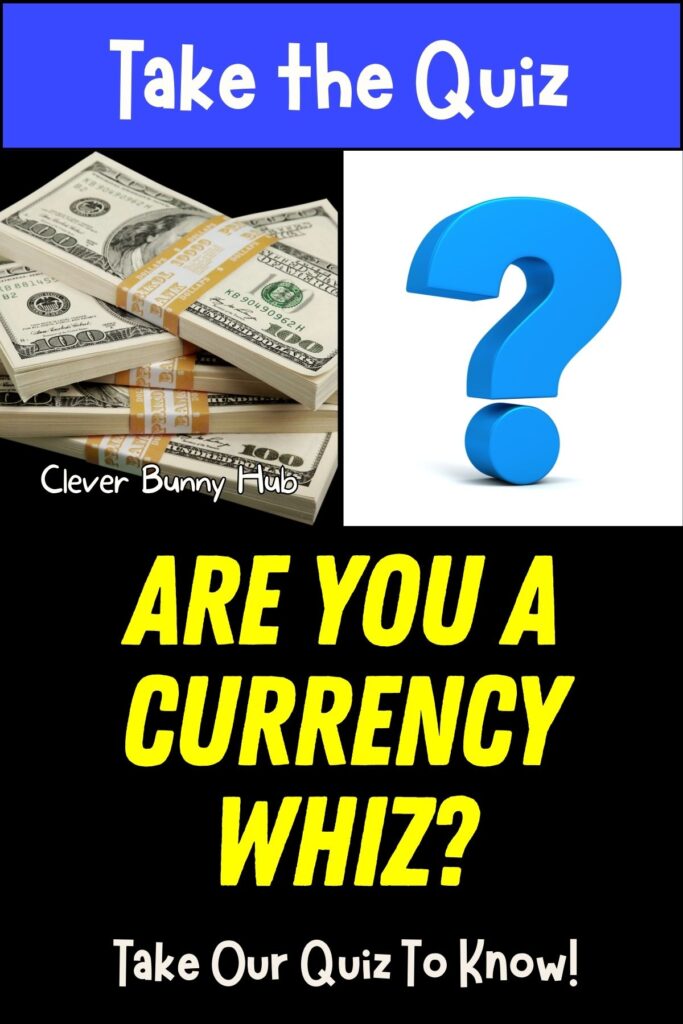Currency plays a pivotal role in our daily lives, yet it’s easy to take it for granted. Apart from its obvious usage in buying goods and services, currency serves as a symbol of national pride, history, and culture. With that in mind, why not embark on a thrilling currency quiz to test your knowledge and uncover intriguing facts about banknotes from around the world? Get ready to be captivated by the stories behind the bills you see every day!
Our quiz is designed to challenge even the savviest currency enthusiasts. From the iconic dollar bills to the lesser-known coins, we’ve curated a set of questions that will take you on a virtual tour of currencies from around the world. Whether you’re familiar with the yen, euro, rupee, or beyond, this quiz is your chance to showcase your expertise.
As you progress through this adventure, you’ll come across questions on the symbolism of currency, and the distinguishing traits that define them. This quiz promises to put your currency knowledge to the ultimate test, whether you’re an enthusiastic collector or simply interested in the world of money. It’s not just about knowing the obvious; it’s about recognizing the subtle differences that distinguish one currency from another.
As you progress, you’ll gain a deeper understanding of the currencies that shape our global economy. Push the boundaries of your currency knowledge and discover new facts along the way. This quiz is your platform to demonstrate your mastery of the captivating realm of currencies.
Engage in a quiz that combines fun elements with valuable insights, making the learning experience enjoyable. Encourage your friends, family, or colleagues to join in. Let’s see who emerges as the true “Currency Whiz” in your circle.
So, are you ready to prove that you’re a true aficionado of global currencies? Take our quiz and unlock the title of “Currency Whiz” by showcasing your expertise in the captivating world of money.
1. What is the official currency of Japan?
Japan’s official currency is the yen, represented by the symbol “¥” and the ISO code “JPY” (Japanese Yen). As one of the world’s major currencies, the yen holds a prominent place in the global economic landscape. Its origins trace back to the Meiji Restoration in the late 19th century when Japan underwent a period of rapid modernization and adopted the yen as its official currency in 1871. Since then, the yen has played a crucial role in facilitating trade, commerce, and financial transactions both domestically and internationally. The Bank of Japan, the country’s central bank, oversees the issuance and regulation of the yen, ensuring its stability and integrity within the Japanese economy. The yen’s significance extends beyond its monetary value, as it reflects Japan’s economic prowess and its influence in the international financial arena. This introduction provides a glimpse into the historical and economic aspects that define the official currency of Japan.
2. The currency used in Switzerland is:
Switzerland, renowned for its stunning landscapes, precision engineering, and financial prowess, utilizes the Swiss Franc as its official currency. Denoted by the symbol “CHF” and the ISO code “CHF,” the Swiss Franc plays a central role in the nation’s economic identity. Established in 1850, the Swiss Franc has weathered economic fluctuations and retained its reputation for stability. As a country known for its neutrality and robust financial sector, Switzerland’s currency reflects its commitment to fiscal strength and reliability. Governed by the Swiss National Bank, the Swiss Franc stands as a symbol of the country’s economic resilience and global financial standing. This introduction provides a brief overview of the currency that underpins Switzerland’s economic landscape and contributes to its international standing.
3. Which country uses the currency named “Zloty”?
The currency known as the “Zloty” is the official monetary unit of Poland. Represented by the symbol “PLN” and the ISO code “PLN,” the Zloty has a rich history dating back to medieval times. The term “Zloty” translates to “golden” in Polish, originally referring to a gold coin used in trade during the Middle Ages. Modern-day Poland adopted the Zloty as its official currency after the collapse of the communist regime in the early 1990s, marking a significant economic and political transformation. Managed by the National Bank of Poland, the Zloty plays a crucial role in the country’s domestic and international economic activities. This introduction provides a glimpse into the historical and economic context of the currency that defines Poland’s monetary landscape.
4. The official currency of South Korea is:
South Korea, a dynamic and technologically advanced nation, operates with the Korean Republic Won (KRW) as its official currency. Symbolized by “₩” and recognized by its ISO code “KRW,” the Won holds a central position in South Korea’s economic landscape. Introduced in 1945 following the nation’s liberation from Japanese occupation, the Won has since undergone several transformations to solidify its role in facilitating trade, commerce, and financial transactions. The Bank of Korea oversees the issuance and regulation of the Won, ensuring its stability within the country’s evolving economic environment. As South Korea continues to be a global economic player, the Won stands as a symbol of its financial strength and commitment to economic development. This introduction provides a brief overview of the official currency that underscores South Korea’s economic vibrancy and international influence.
5. The currency of Ghana is called the Ghanaian Cedi. What symbol represents the cedi?
Nestled on the West African coast, Ghana boasts a rich tapestry of culture, history, and economic vibrancy. At the heart of its financial transactions lies the Ghanaian Cedi, the official currency that mirrors the nation’s economic prowess. Symbolizing this fiscal identity is the currency’s distinctive symbol: ₵. This symbol not only represents the tangible value of the cedi but also encapsulates the aspirations, resilience, and economic aspirations of the Ghanaian people.
6. The currency of Mexico is:
Mexico, a country rich in history, culture, and vibrant landscapes, operates with the Mexican Peso (MXN) as its official currency. Symbolized by the “$” sign and the ISO code “MXN,” the peso has played a pivotal role in shaping Mexico’s economic identity. With a history dating back to colonial times, the peso has witnessed the ebb and flow of Mexico’s economic and political landscape. Managed by the Bank of Mexico (Banco de México), the peso is integral to the nation’s financial stability and trade relations. As one of the most traded currencies in Latin America, the peso reflects Mexico’s position as an economic powerhouse in the region. From the bustling markets of Mexico City to the serene beaches of the Riviera Maya, the peso is the common denominator in the daily transactions that define Mexican life.
7. What is the official currency of Egypt?
The official currency of Egypt, a country steeped in ancient history and cultural richness, is the Egyptian Pound (EGP). Denoted by the symbol “£” and the ISO code “EGP,” the Egyptian Pound holds a central role in the nation’s economic landscape. With a history tracing back to the 19th century, the Egyptian Pound has witnessed the transformative periods of Egypt’s modern history.
Managed by the Central Bank of Egypt (CBE), the pound serves as the medium of exchange for a diverse range of economic activities, from the bustling markets of Cairo to the archaeological sites along the Nile. Egypt’s economy, shaped by a blend of ancient traditions and contemporary developments, relies on the stability and integrity of the Egyptian Pound.
8. The currency of Thailand is:
The Kingdom of Thailand, a nation renowned for its vibrant culture, stunning landscapes, and warm hospitality, utilizes the Thai Baht (THB) as its official currency. Represented by the symbol “฿” and the ISO code “THB,” the Baht has played a crucial role in Thailand’s economic and commercial activities.
Established in 1897, the Thai Baht has witnessed the evolution of Thailand’s economy from agrarian roots to a dynamic, modern society. Managed by the Bank of Thailand, the Baht reflects the country’s commitment to financial stability and economic growth. From the bustling street markets of Bangkok to the tranquil beaches of Phuket, the Thai Baht is the common denominator in the diverse tapestry of transactions that characterize daily life in Thailand.
9. What is the currency of Australia?
Australia, a vast and diverse island continent known for its unique wildlife, stunning landscapes, and vibrant cities, operates with the Australian Dollar (AUD) as its official currency. Symbolized by the “$” sign and the ISO code “AUD,” the Australian Dollar has been the cornerstone of the nation’s monetary system since its introduction in 1966. Managed by the Reserve Bank of Australia (RBA), the Australian Dollar is not only a medium of exchange but also a reflection of the country’s robust and resilient economy. Australia’s economic strength, rooted in sectors such as mining, agriculture, and services, is intricately tied to the stability and value of its currency.
10. Which currency is used in Russia?
Russia, the largest country in the world, spanning two continents and boasting a rich tapestry of history and culture, utilizes the Russian Ruble (RUB) as its official currency. Represented by the symbol “₽” and the ISO code “RUB,” the ruble has been an integral part of Russia’s economic landscape for centuries. The history of the Russian Ruble dates back to the medieval period, evolving through various forms before the modern ruble was established in the early 18th century. Managed by the Central Bank of Russia, the ruble serves as a key player in the country’s economic transactions, both domestically and internationally. Russia’s diverse and expansive economy, influenced by industries such as energy, manufacturing, and technology, is closely tied to the stability and value of the ruble. From the iconic landmarks of Moscow to the vast Siberian wilderness, the ruble is the common currency that facilitates the daily transactions shaping life in this vast and dynamic nation.
11. The currency of Brazil is:
Brazil, a country known for its vibrant culture, diverse ecosystems, and dynamic cities, operates with the Brazilian Real (BRL) as its official currency. Symbolized by the abbreviation “R$” and the ISO code “BRL,” the Real has been the cornerstone of Brazil’s monetary system since its introduction in 1994. Managed by the Central Bank of Brazil (Banco Central do Brasil), the Real plays a pivotal role in the nation’s economic landscape. Brazil’s economy, fueled by industries such as agriculture, mining, and manufacturing, is closely tied to the stability and value of its currency.
12. In which country is the currency “Forint” used?
The currency known as the “Forint” is the official monetary unit of Hungary. Represented by the symbol “Ft” and the ISO code “HUF,” the Forint has been an integral part of Hungary’s economic landscape for several decades. With a history dating back to 1946, the Forint replaced the Hungarian Pengő and has since played a crucial role in facilitating trade, commerce, and financial transactions within the country. Managed by the Hungarian National Bank (Magyar Nemzeti Bank), the Forint reflects Hungary’s economic stability and resilience. As a member of the European Union, Hungary maintains its own currency, the Forint, despite being part of the broader Eurozone.
13. The official currency of South Africa is:
South Africa, a nation characterized by its diverse landscapes, rich cultural heritage, and significant economic influence on the African continent, operates with the South African Rand (ZAR) as its official currency. Symbolized by the abbreviation “R” and the ISO code “ZAR,” the Rand has been an integral part of South Africa’s economic identity since its introduction in 1961.
Managed by the South African Reserve Bank (SARB), the Rand is a symbol of the country’s economic strength and stability. South Africa’s economy, shaped by industries such as mining, agriculture, and services, relies on the stability and value of its currency. From the iconic Table Mountain in Cape Town to the wildlife-rich Kruger National Park, the Rand is the common currency that facilitates transactions across the diverse and vibrant nation.
14. The currency of Vietnam is:
Vietnam, a nation marked by its rich history, vibrant culture, and breathtaking landscapes, utilizes the Vietnamese đồng (VND) as its official currency. Represented by the symbol “₫” and the ISO code “VND,” the đồng has been an integral part of Vietnam’s economic landscape for several decades.
Established in 1978, the Vietnamese đồng replaced the previous North Vietnamese đồng and has since played a crucial role in facilitating trade, commerce, and financial transactions within the country. Managed by the State Bank of Vietnam, the đồng reflects Vietnam’s economic growth and stability.
15. The currency used in Saudi Arabia is:
Saudi Arabia, a country known for its rich cultural heritage, vast deserts, and modern urban centers, operates with the Saudi Riyal (SAR) as its official currency. Symbolized by the abbreviation “ر.س” and the ISO code “SAR,” the Riyal has been the cornerstone of Saudi Arabia’s monetary system for several decades. Managed by the Saudi Arabian Monetary Authority (SAMA), the Riyal plays a pivotal role in the nation’s economic landscape. As one of the leading economies in the Middle East, Saudi Arabia’s financial stability is closely tied to the strength and value of its currency. From the gleaming skyscrapers of Riyadh to the historical sites of Jeddah, the Saudi Riyal is the common currency that facilitates transactions and economic activities across diverse and dynamic countries.
16. In which country is the currency “Dirham” used?
The currency known as the “Dirham” is used in several countries across the Middle East and North Africa, but one of the most prominent is the United Arab Emirates (UAE). In the UAE, the official currency is the UAE Dirham (AED), symbolized by “د.إ” and the ISO code “AED.” The Dirham has played a crucial role in the economic development and global positioning of the UAE. Managed by the Central Bank of the United Arab Emirates, the Dirham reflects the economic strength and stability of the nation. As a hub for international business and tourism, the UAE’s currency is a key player in facilitating transactions and financial activities within the country and beyond. From the modern skyline of Dubai to the cultural richness of Abu Dhabi, the UAE Dirham is the common currency that underpins the diverse economic activities in this dynamic region.
17. In India, what does the term “Rupee” mean in Sanskrit?
In Sanskrit, the term “Rupee” finds its roots in the word “rupya,” which means “wrought silver” or “coin of silver.” This linguistic connection reflects the historical significance of the Rupee as a unit of currency in India. The Rupee has been an integral part of the country’s monetary system for centuries, witnessing historical changes and economic transformations.
The usage of the term “rupya” highlights the traditional association of the Rupee with silver currency, echoing a time when precious metals played a central role in shaping the economic systems of ancient civilizations. Today, the Indian Rupee (INR), symbolized by “₹” and the ISO code “INR,” remains a vital component of India’s economic landscape, reflecting its historical continuity and cultural resonance.
18. Which country’s currency features an image of the national bird, the kiwi, on its coins?
New Zealand, a picturesque island nation in the southwestern Pacific Ocean, boasts a unique and captivating element on its currency – the image of the national bird, the kiwi. Renowned for its stunning landscapes, diverse wildlife, and rich Maori culture, New Zealand takes pride in incorporating the emblematic kiwi into its monetary representation. The kiwi, a flightless and nocturnal bird endemic to New Zealand, serves as a symbol of the country’s distinctive natural heritage.
19. Which Asian country uses the Tugrik as its official currency?
The Tugrik serves as the official currency of Mongolia, a landlocked country in East Asia known for its vast steppes, nomadic traditions, and rich cultural heritage. Symbolized by “₮” and represented by the ISO code “MNT,” the Tugrik has been an integral part of Mongolia’s monetary system since 1925.
Managed by the Bank of Mongolia (Mongolbank), the Tugrik plays a pivotal role in the country’s economic landscape. Mongolia, nestled between Russia and China, has experienced significant economic changes in recent decades, and the Tugrik reflects the nation’s commitment to financial stability and development.
20. The shekel is the currency of which Middle Eastern country?
The shekel is the official currency of Israel, a country situated in the heart of the Middle East, known for its historical significance, diverse culture, and vibrant cities. Symbolized by “₪” and represented by the ISO code “ILS,” the shekel has been a central component of Israel’s monetary system since the country’s establishment in 1948.
Managed by the Bank of Israel, the shekel plays a crucial role in facilitating trade, commerce, and financial transactions within the nation. Israel, with its unique blend of ancient history and modern innovation, has developed a dynamic and resilient economy, and the stability of the shekel reflects the country’s commitment to economic growth and financial stability.
21. Which African country uses the Nakfa as its official currency?
The Nakfa is the official currency of Eritrea, a country located in the Horn of Africa. Symbolized by “Nfa” and represented by the ISO code “ERN,” the Nakfa has been the cornerstone of Eritrea’s monetary system since the country gained independence in 1993.
Managed by the Bank of Eritrea, the Nakfa plays a crucial role in facilitating trade, commerce, and financial transactions within the nation. Eritrea, with its diverse landscapes ranging from the Red Sea coastline to the rugged highlands, has built its economic foundation around industries such as agriculture and mining, and the Nakfa reflects the country’s commitment to financial stability and development.
22. The Egyptian Pound is divided into what subunit?
The Egyptian Pound (EGP), the official currency of Egypt, is divided into smaller units known as piastres or qirsh. The term “piastre” is commonly used in everyday transactions, and it is represented by the symbol “Pt” or “قرش” in Arabic. One Egyptian Pound is equivalent to 100 piastres.
This subdivision allows for flexibility in pricing and facilitates transactions, particularly in the realm of everyday commerce. The piastre has historical significance, reflecting Egypt’s economic history and its influence on the currency system. As a subunit of the Egyptian Pound, the piastre plays an essential role in shaping the monetary landscape of the country, contributing to the ease and efficiency of financial transactions.
23. The Turkish Lira features an image of which historical figure on its banknotes?
A. Suleiman the Magnificent
The Turkish Lira, the official currency of Turkey, has a rich and visually compelling representation on its banknotes, featuring the portrait of Mustafa Kemal Atatürk. Mustafa Kemal Atatürk, the founder of the Republic of Turkey and its first President, is an iconic figure in Turkish history, known for his leadership in the country’s transformation from the Ottoman Empire to a modern, secular state.
Atatürk’s image on the Turkish Lira pays homage to his significant contributions in shaping Turkey’s political, social, and cultural landscape. His presence on the banknotes serves as a reminder of the nation’s commitment to its founding principles, including secularism, nationalism, and modernization.
24. What animal is featured on the reverse side of the Australian one-dollar coin?
The Australian one-dollar coin, a distinctive piece of currency in the nation’s monetary system, showcases an iconic Australian marsupial on its reverse side — the kangaroo. With its powerful hind legs and distinctive hopping movement, the kangaroo is not only a symbol of Australia’s unique wildlife but also a representation of the country’s identity and cultural heritage.
The kangaroo has long been associated with Australia, and its depiction on the one-dollar coin emphasizes the nation’s rich biodiversity and commitment to preserving its natural environment. The use of native animals on currency is a unique way to celebrate Australia’s fauna, making the one-dollar coin not only a practical medium of exchange but also a miniature canvas that tells a story of the country’s natural beauty.
25. The Kuwaiti Dinar is the highest-valued currency unit in the world. What is its subdivision?
The Kuwaiti Dinar is subdivided into 1,000 fils. This division allows for flexibility in pricing and facilitates transactions, particularly in the realm of everyday commerce. The fils, represented by the symbol “فلس,” serve as the smaller unit of the Dinar, contributing to the efficiency and precision of financial transactions within Kuwait.
26. What symbol represents the Dollar?
In the world of money, symbols speak a language of their own, and when it comes to the United States Dollar, there’s a symbol that everyone recognizes: “$”. This simple yet powerful symbol represents the backbone of the U.S. economy and holds a special place in global trade.
That’s a shame, sit up.
Oops! Looks like you need to brush up on your currency knowledge. Scoring this suggests there’s room for improvement, but don’t worry! Consider reviewing currency symbols, exchange rates, and global monetary systems to boost your knowledge. Keep exploring and learning – success is just a bit more study away!”
Well done!
It looks like you’re on the right track. Scoring this indicates a solid understanding of various currencies, symbols, and exchange rates. You’re well-versed in the world of money! Keep up the good work and continue exploring the fascinating realm of global currencies.
Bravo!
Wow! You are a true currency whiz! Your knowledge of global currencies is impressive. Scoring this showcases an exceptional understanding of global currencies, symbols, and exchange rates. You’re a true currency connoisseur! Your knowledge reflects a keen awareness of the intricacies of monetary systems worldwide. Keep up the impressive work, and consider yourself a true expert in the realm of currencies.
Related Posts































